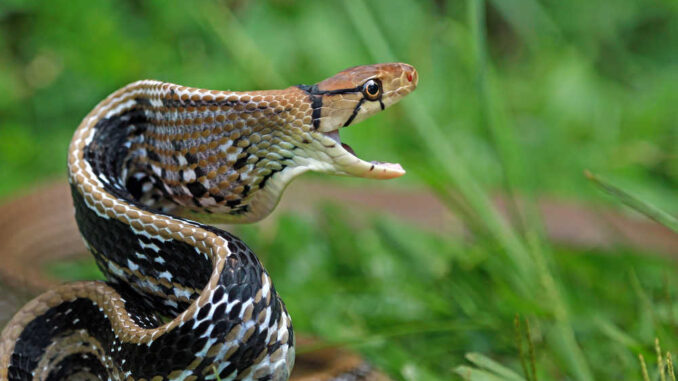
Copperheads were common around my hometown when I was growing up. Although I never encountered one, I was taught what to do if I or my dog experienced a venomous snake bite from one. I learned early that rapid response and prompt treatment can help minimize the effects your dog experiences from a bite.
In this article, we’ll examine the severity of copperhead bites in dogs, the importance of early treatment, and the signs that you have an emergency. I’ll explain what you should do if your dog is bitten by a copperhead snake, including first aid treatment. When first aid isn’t enough for your pooch, I’ll let you know what to expect a the vet. We’ll also look at ways to prevent copperhead bites.
Copperhead bite severity for small and large dogs
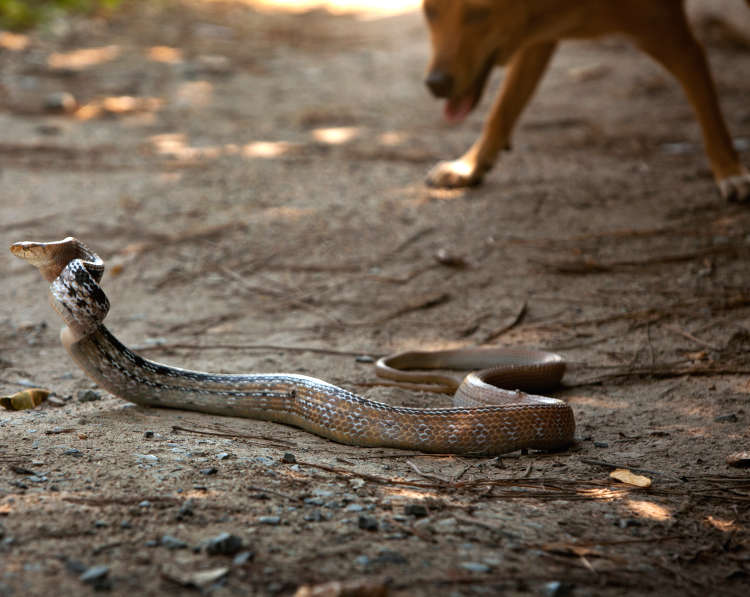
According to a 2014 case study of 52 dogs treated after being bitten by a copperhead, the symptoms of envenomation tend to be local and self-limiting with proper treatment. Therefore, you should treat any bite as an emergency to ensure the best possible outcome.
Most dogs will survive a bite by one of these vipers with proper treatment. The severity of the signs your dog may experience varies. Several factors affect your dog’s reaction.
- Very young, very old, and diseased dogs usually have more severe reactions.
- Small dogs will naturally get a higher dose of venom per pound of body weight, so they have a higher risk of severe complications.
- Bites to the face and legs tend to provoke less severe responses than those to the tongue or trunk because the former areas have fewer blood vessels.
- Dogs that are active or hyper after a snake bite tend to have more severe reactions to the toxins than those that remain calm.
- The dose the snake injects into your dog will affect the severity of the response. If the snake has recently bitten another animal, the concentration of toxin will be less, which is good news for your dog.
Importance of getting treatment quickly
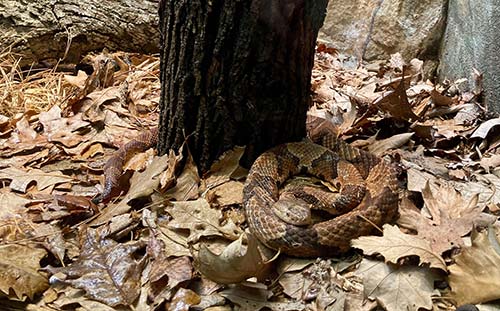
If you suspect your dog was bitten by a Copperhead snake, take him to the vet immediately. Early treatment can help make the recovery easier for your dog. Without proper and timely veterinary care, your furbaby’s reaction to the toxin can be moderate or severe and may include seizures or death.
Clinical signs that your dog’s condition is an emergency
Copperhead venom can be fatal to your dog if he doesn’t get treatment quickly. You may not see the snake bite your dog, but if you notice any of the following symptoms, treat it as an emergency and take him to the vet. It’s better to play it safe than to wait too long to seek care.
- Fang marks
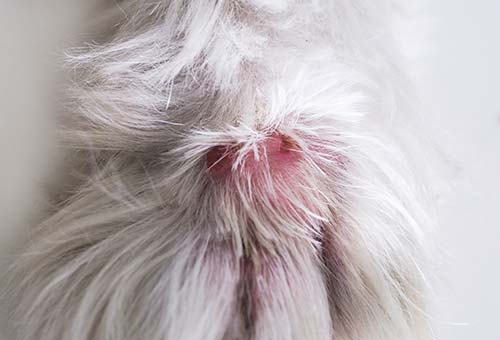
Snake bite on a dog’s foot. Notice the two red dots, local swelling, and redness of the surrounding tissue.
If you’ve been out in the woods and notice a pair of red dots about one centimeter apart on your dog’s skin, it may be a snake bite. There may also be fluid or blood seeping from the puncture wounds.
- Swelling – The wound may exhibit rapid swelling, and the affected area will be darker red than normal skin. In a few hours, there will be a noticeable lump.
- Altered behavior – Your dog may limp, paw at his face, or act like he’s in pain or distress. Some dogs will become nervous or skittish after a snakebite.
- Drooling or foaming at the mouth – This can be an early symptom in some dogs as the venom spreads to other body systems.
- Vomiting and diarrhea – As the venom spreads to other body systems, you may see vomiting and diarrhea. These symptoms usually develop after a few hours.
- Panting – If your dog has an allergic reaction to the venom, he may experience respiratory distress. He may pant or have heavy breathing. This symptom is more common when the snake bites your dog’s head or neck area.
- Lethargy and collapse – In severe reactions, the venom reaches core body systems and can cause clotting, muscle tremors, lethargy, and collapse.
What to do if your dog is bitten by a copperhead snake
If you’re outside with your dog and he suddenly yelps and runs over to you, he may have been bitten by a snake such as a copperhead. Check for bite marks and other signs.
If you see the snake bite your dog, remove your dog from the area. Try to identify the snake if possible. You may be able to snap a photo and send it to your vet. Once you and your pooch are safe:
- Call your veterinarian immediately and let him know what happened. Follow his directions for care.
- Keep your dog calm and check him for other symptoms. Try to prevent your pup from pacing or moving around. Staying quiet helps to prevent an elevated heart rate and slows the spread of the toxin.
- Reassure your dog with quiet tones and petting to reduce his anxiety level.
- Do not attempt to suck out the venom or apply a tourniquet. The venom is already in your dog’s bloodstream, so you won’t be able to suck it out. Tourniquets can cause tissue damage and necrosis.
- Remove your dog’s collar, especially if the bite is around the face or neck.
- Rinse the wound and keep it clean.
- Keep the wound below your dog’s heart to slow spread to other organs if possible.
First aid for copperhead bites in dogs
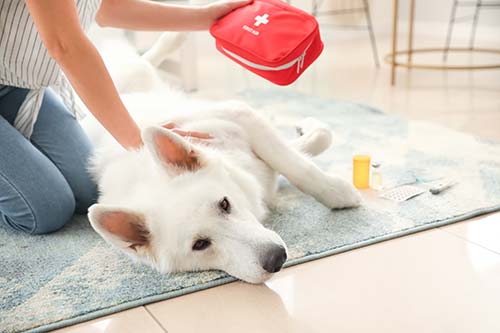
If your dog has a copperhead snake bite, you must get him to the vet immediately for emergency care. Keep him calm and quiet during transport.
Some veterinarians recommend giving your furbaby some Benadryl to help relieve symptoms of inflammation and swelling and keep him calmer. This is not a substitute or alternative to antivenom, and it will not slow the spread of the toxins.
Can first aid be enough?
When a venomous snake bites your dog, first aid isn’t enough. Any toxin the snake injected into the skin is in the bloodstream and can spread to other body symptoms. Even if you administer Benadryl to your dog, you must get him to the vet as soon as possible. Without prompt treatment, your dog may develop more severe symptoms including drooling, lethargy, and collapse.
Veterinary treatment to expect for copperhead snake bites
When you take your dog to the veterinarian for a copperhead snake bite, the type of treatment will vary depending on the type of bite and severity of the symptoms. If your dog sustains a dry snake bite, your vet will not administer antivenom.
A dry snake bite is a warning from the viper. With this type of strike, the snake does not inject venom into the wound. It can be hard to distinguish between a dry or wet(venom-injected) bite at first, but your veterinarian will check for signs of toxin. If the bite is dry, he will treat the wound with antiseptics, anti-inflammatory drugs, and antibiotics to ease discomfort and reduce the risk of a secondary infection.
For regular copperhead snake bites, the veterinarian may administer antivenom if your dog’s symptoms are severe enough to call for it. Other treatment generally includes:
- Hospitalization and observation for 24-36 hours
- Antimicrobial drugs
- Painkillers or anti-inflammatory medications
- Antihistamines
- IV fluids
What does a copperhead snake look like?
Depending on where you live, copperhead snakes are not the only kind of serpent your dog may encounter. Knowing how to identify the viper can help you and your veterinarian choose the best possible treatment.
As vipers, copperhead snakes have a triangular head with narrow eye slits. They tend to be shorter in length than many other snakes, and their body has hourglass spots.
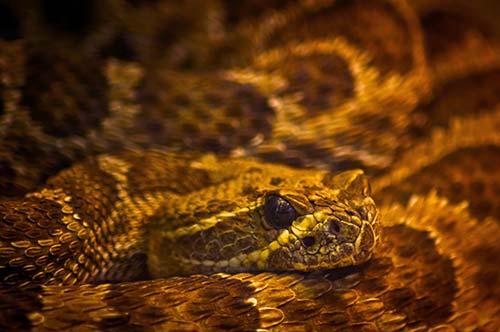
Copperheads like to blend into their surroundings and will lay in leaf piles or other places. Unlike many other snakes, they don’t slither away when approached but freeze in place. Unfortunately, this behavior means you or your dog are more likely to accidentally step on one resulting in a bite.
How can you prevent your dog from being bitten by a copperhead snake?
If you live in copperhead country, there are things you can do to prevent the risk of a snake bite.
In the yard
Many times, dogs encounter copperhead snakes in their yards. To reduce the likelihood that one of these vipers enters your property:
- Keep your lawn well-groomed
- Install a snake fence
- Plant snake-repelling plants around the yard
- Keep woodpiles, storage sheds, and landscaping supplies at the perimeter of the yard and away from the house
- Check your property regularly for holes and fill them in to discourage rodents
On the trail
When you take your dog out for a walk or other outing, know your surroundings.
- Don’t let your dog stick his head in the brush, tall grasses, or holes
- Leash-walk your dog in high-risk areas
- Stay on walking paths
- Be on the alert for snakes as you walk
- Give your dog obedience training to help him stay under control
Frequently asked questions
Does antihistamine work for snake bites?
While your veterinarian may administer antihistamines in the case of an allergic reaction to the venom, it is ineffective in neutralizing the toxins. Most swelling from snake bites is caused by cellular damage, not histamine release.
Should my dog get snake antivenom if a copperhead snake bites him?
Your veterinarian will determine whether your dog needs snake antivenom after sustaining a copperhead bite. Usually, wounds are local and self-limiting. Supportive treatment with hospitalization and monitoring is sufficient.
Disclaimer: This website's content is not a substitute for veterinary care. Always consult with your veterinarian for healthcare decisions. Read More.


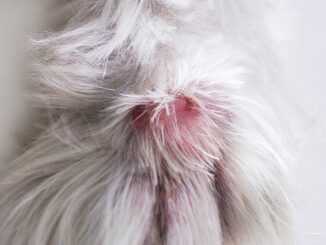
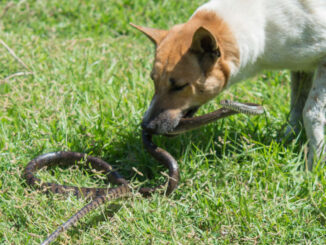
Why isn’t there an at home injectable shot that you can administer to your pet (like the human EpiPen) to be used immediately after a pet has been bitten by a snake? Of course the best course of action is to rush your pet to the nearest ER. I was just hoping for some other advice other that giving your pet a Benadryl to keep them calm BEFORE I would load my pet into the car drive like a crazy person to the ER.
Hi there! Thanks for your interesting question. There is a few reasons for this.
Anti venom is a prescription only medicine and has to be administered by a vet. Giving it incorrectly can make it ineffective.
It has to be given intravenously (directly into a vein). An Epi pen is given into the muscle, which makes it possible for it to be given by the patient themselves (or someone else).
The type of anti venom used depends on the snake encountered and larger emergency hospitals will have access to each type (many also stock polyvalent ones, which work on a range of species of snake’s bites).
Anti venom is expensive and has to be stored in a specific way. It also goes off after an amount of time. So it makes sense for it to be stocked by the emergency clinic (a central hub), rather than for them to ask every dog owner to buy it and discard it once it goes out of date.
Oftentimes, dogs need more than one injection.
Dogs do need emergency care when bitten, so we’d want to avoid any situation where an owner would try to provide treatment from home, and then not seek veterinary care, which could put their dog’s life at risk.
“The information on this website is not a substitute for in-person veterinary care. Always seek advice from your veterinarian if you have concerns about your pet’s medical condition.”